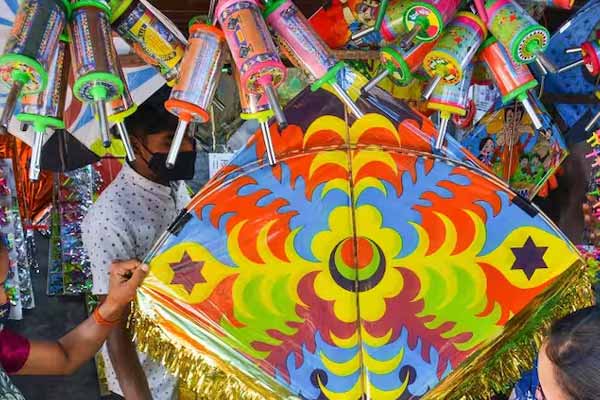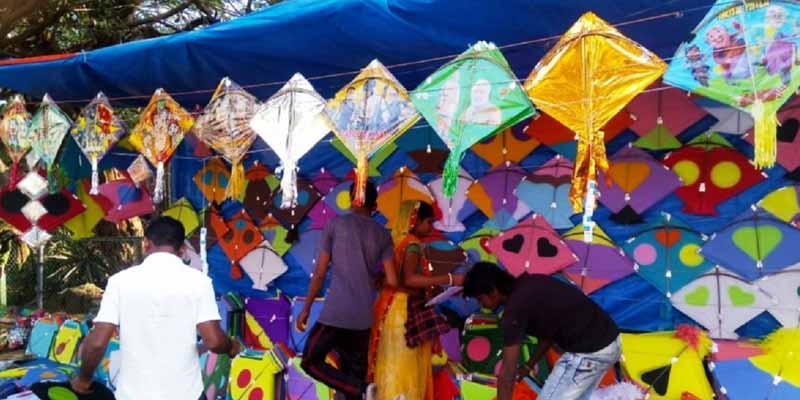Makar Sankranti Festival in Rajasthan, a significant harvest festival, is celebrated with great enthusiasm in the vibrant state of Rajasthan, India. The festival marks the transition of the sun into the zodiac sign of Capricorn (Makara) and is observed on January 14th to 15th every year. In Rajasthan, this auspicious day is known by various names, including “Makar Sankrant,” “Uttarayan,” or “Khichdi.”
Rajasthan, known for its rich cultural heritage, colors, and traditions, comes alive during Makar Sankranti. The festival holds immense cultural and social importance, symbolizing the end of winter and the arrival of longer days. People in the state engage in a myriad of festivities, bringing communities together in joyous celebrations.

One of the distinctive aspects of Makar Sankranti in Rajasthan is the tradition of flying kites. The sky becomes a canvas adorned with colorful kites of various shapes and sizes. The kite-flying competitions, locally known as “patang baazi,” add an element of thrill and competition to the celebrations. The skies of cities like Jaipur, Udaipur, and Jodhpur are filled with the vibrant hues of kites, creating a spectacular sight, Makar Sankranti Festival in Rajasthan.
Traditional Rajasthani sweets and dishes play a vital role in the Makar Sankranti festivities. The preparation of special delicacies like sesame and jaggery-based sweets, known as “til ke laddu” and “gajak,” is a customary practice. Families come together to prepare and share these delectable treats, strengthening bonds and fostering a sense of community.
Apart from the kite-flying and culinary delights, Makar Sankranti is also observed with religious fervor in Rajasthan. Pilgrims throng to holy rivers, lakes, and temples to take ritualistic dips and offer prayers. The Pushkar Fair, one of the most renowned cattle fairs in the state, coincides with Makar Sankranti, attracting a large number of visitors and traders.
In conclusion, Makar Sankranti Festival in Rajasthan is a harmonious blend of cultural traditions, festive fervor, and religious rituals. The colorful kites soaring high in the sky, the aroma of traditional sweets, and the religious rituals create an atmosphere of joy and togetherness, making it a cherished celebration for the people of Rajasthan.

Special highlights of the festival:
- The festival is celebrated on a huge scale in Jaipur, and it is called International Kite flying festival.
- The state tourism department organizes this festival in Jaipur Polo ground, where competitions are held and various prizes are given away.
- There are various clubs and communities where this sport gets ardently practised before the festival.
- Such is the popularity of this festival that the state tourism declares a public holiday. Schools and shops remain closed, and people are geared up to welcome the festival.
- Indian sweets made during this festival are prepared with sesame seeds and some of the popular ones are Til ladoo, Sesame brittle, ghevar etc.
History of Rajasthan Kite Festival
The Rajasthan Kite Festival, also known as Makar Sankranti or Uttarayan, has a rich history deeply rooted in the cultural fabric of the state. The festival is celebrated to mark the transition of the sun into the zodiac sign of Capricorn, and it usually falls on January 14th Makar Sankranti Festival in Rajasthan.
The tradition of flying kites during Makar Sankranti has been prevalent in Rajasthan for centuries. The origins of kite flying during this festival can be traced back to the royal courts of the Rajput kings, where it was a popular form of entertainment and a symbol of valor. The Rajputs were known for their martial skills, and kite flying became a way for them to showcase their expertise in the art, Makar Sankranti Festival in Rajasthan.
Over time, kite flying evolved from being a royal pastime to a popular and widespread tradition among the common people of Rajasthan. The festival gained cultural significance, not just as a form of entertainment but also as a means of celebrating the changing seasons and the arrival of longer days.
The vibrant and colorful kites that fill the skies during the festival are not just objects of recreation but also carry deeper symbolic meanings. The various shapes, sizes, and colors of kites represent the diverse cultures, traditions, and communities coming together in harmony. The festival is a visual spectacle as the sky becomes a canvas painted with a myriad of hues, creating a breathtaking panorama.
The Rajasthan Kite Festival also has a social aspect, promoting camaraderie and friendly competition. Kite flying competitions, locally known as “patang baazi,” are organized, adding an element of excitement to the festivities. Kite enthusiasts from different regions come together to showcase their skills and engage in friendly duels, making the festival a time for bonding and celebration.
In recent years, the Rajasthan government has actively promoted the Kite Festival as a major tourist attraction, drawing visitors from across the country and around the world. The festival has become an integral part of the state’s tourism calendar, contributing to the promotion of Rajasthan’s rich cultural heritage, Makar Sankranti Festival in Rajasthan.
In essence, the history of the Rajasthan Kite Festival is a journey from the royal courts of the Rajputs to the vibrant streets where people from all walks of life come together to celebrate tradition, culture, and the spirit of unity Makar Sankranti Festival in Rajasthan.
The famous tourist spots in Rajasthan for Makar Sankranti
Rajasthan, known for its rich cultural heritage and vibrant celebrations, offers a plethora of tourist spots to experience the festivities of Makar Sankranti. During this auspicious festival, various cities and regions in Rajasthan come alive with traditional rituals, colorful events, and kite-flying competitions. Here are some famous tourist spots in Rajasthan where you can witness and participate in the Makar Sankranti celebrations:
Jaipur: The capital city of Rajasthan, Jaipur, is a hub of Makar Sankranti festivities. The city’s iconic landmarks, such as Hawa Mahal and Jal Mahal, become the backdrop for kite flying enthusiasts. The skies are dotted with kites of all shapes and sizes, creating a vibrant and lively atmosphere Makar Sankranti Festival in Rajasthan.
Jodhpur: Known for its majestic Mehrangarh Fort and Umaid Bhawan Palace, Jodhpur celebrates Makar Sankranti with enthusiasm. The traditional kite-flying competitions, along with cultural events, make the city a lively destination during the festival.
Udaipur: The picturesque city of Udaipur, with its beautiful lakes and palaces, is a charming setting for Makar Sankranti celebrations. The lakeside areas and parks become popular spots for kite flying, and the city hosts cultural events to add to the festive spirit Makar Sankranti Festival in Rajasthan.
Pushkar: Famous for the Pushkar Fair, which coincides with Makar Sankranti, Pushkar attracts a large number of tourists and pilgrims during this time. The sacred Pushkar Lake and the vibrant fairground become venues for both religious rituals and cultural festivities.
Bikaner: This desert city is known for its Junagarh Fort and camel safaris. During Makar Sankranti, Bikaner hosts kite-flying competitions and other cultural events. The historic forts and palaces provide a unique backdrop to the celebrations.
Jaisalmer: The Golden City of Jaisalmer, with its sand dunes and majestic forts, offers a distinct experience during Makar Sankranti. Kite flying against the backdrop of the golden-hued desert creates a surreal and memorable atmosphere.
Kota: Kota, situated on the banks of the Chambal River, celebrates Makar Sankranti with grandeur. The Chambal Gardens and Kishore Sagar Talab are popular spots for kite enthusiasts, and the city hosts kite festivals and cultural programs Makar Sankranti Festival in Rajasthan.
Shekhawati Region: Known for its beautifully painted havelis, the Shekhawati region celebrates Makar Sankranti with traditional fervor. The narrow lanes and courtyards of towns like Mandawa and Nawalgarh witness enthusiastic kite-flying competitions and cultural events Makar Sankranti Festival in Rajasthan.
These tourist spots in Rajasthan provide a diverse range of experiences during Makar Sankranti, allowing visitors to immerse themselves in the cultural richness and festive spirit of the state.